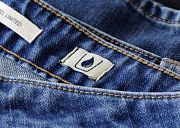SPONSORED CONTENT - Reduce. Reuse. Recycle. Every day there are more designers and brands embracing sustainable practices, producing clothing that is made to last, and establishing recycling programs. As recycling programs continue to gain popularity among brands apparel is extending its end life. About 80 percent of these recycling programs result in either routing these clothes to thrift stores, shipping them overseas, or converting garments into rags, among other reuses. However, what happens at the end of the reuse and repurpose lifecycle is just as important. This is where a garment’s ingredients are critical, and DuPont™ Sorona® fabrics are the formula.
When reviewing a clothing label it is important to know that triexta, elasterell-p, and elastomultiester are all specialty polyester fibers based on partially plant-based DuPont™ Sorona® polymer, and may be sorted into today’s polyester fabric recycling streams. Only about one-fifth of garments collected today get mechanically recycled – or ‘downcycled’ – into post-consumer fiber for home insulation, carpet padding and the automotive industry. Most of these fabrics are 100 percent polyester, 100 percent cotton or 100 percent wool fabrics, as other fiber blends may cause compatibility issues when it comes to mechanical recycling.
There are four primary methods of recycling textiles today: fiber-to-fiber, mechanical, chemical and incineration. The quality of the feedstock becomes less critical with chemical recycling, where the polymeric bonds are broken to create new monomers, or with incineration, where the energy value of plastic waste is recovered. Where the physical properties of the material being recycled are more of a focus area, is with mechanical or fiber-to-fiber recycling.
One of the major challenges to mechanical recycling is the complexity of textile composition – from different fibers and fiber blends, to dyes and surface treatments. To simplify the process, textiles with multiple fibers often end up in landfills or are used for energy through incineration. If a product is not 100 percent cotton, 100 percent polyester or 100 percent wool, then that material is quickly diverted from mechanical recycling. That is why it is important to understand that if a polyester stretch garment does not have spandex on the label, but has elasterell-p or elastomultiester to enhance the garment’s performance, it too can be mechanically recycled.
Mechanical recycling typically includes crushing, grinding or shredding of garments, followed by re-melting and extrusion into resin pellets. All thermoplastics, including 37 percent annually renewable plant-based Sorona® polymer, can be re-melted to produce new plastics. Bio-based Sorona® fabrics can be sorted into today’s 100 percent polyester recycling streams without compatibility issues.
Sorona® polymer-based fibers offer the perfect comfort stretch performance without breaking down overtime due to heat, UV rays, or chlorine exposure. Thus, clothes continue to look, feel, and perform great every time they are worn. This not only lengthens the lifespan of the garment, but when the time comes to discard, the fabric can be mechanically recycled, unlike stretch garments with spandex that tend to end up in the landfill.
It is critical that everyone – from designers to those that handle the material in the recycling facilities – is aware of a stretch fiber option that can be mechanically recycled in a 100 percent polyester construction: DuPont™ Sorona® fabrics. Leveraging these fabrics will ultimately result in softening the industry’s impact on the environment, and helping to sustain our world’s future.
























































































